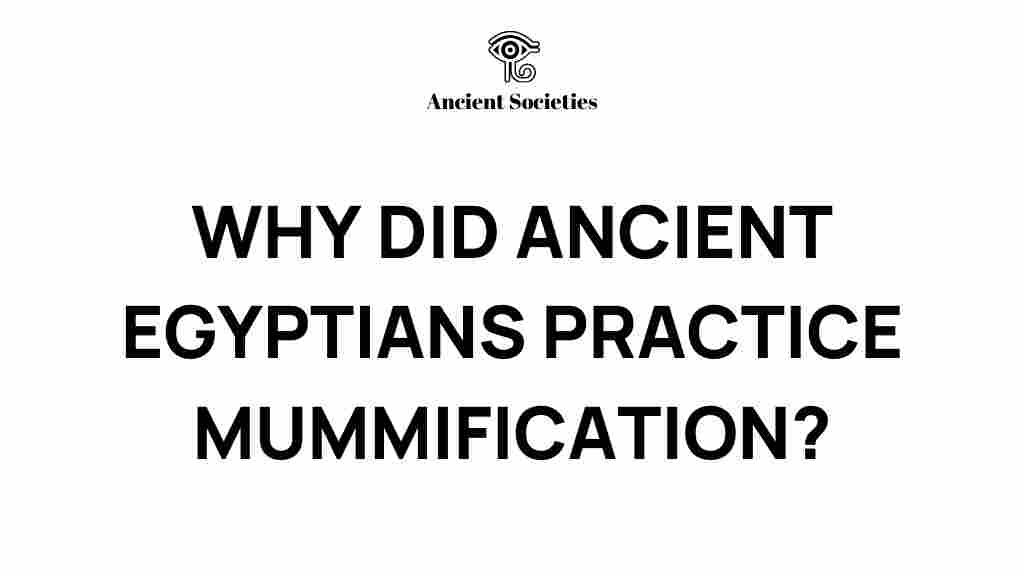Unveiling the Secrets: Why Did Ancient Egyptians Embrace Mummification?
The ancient Egyptians are renowned for their elaborate burial practices, with mummification being one of the most intriguing aspects of their culture. This complex process of preservation was deeply embedded in their beliefs about the afterlife and the soul’s journey after death. In this article, we will explore the reasons behind the ancient Egyptians’ embrace of mummification, delve into their cultural beliefs, and examine the archaeological findings that illuminate these practices.
The Significance of Mummification in Ancient Egypt
Mummification was more than just a method of preserving the dead; it was a ritual that reflected the ancient Egyptians’ profound beliefs about life, death, and the afterlife. The ancient Egyptians believed that the soul, or ‘Ba’, would continue to exist in the afterlife, and in order to do so, the body needed to be preserved. Here are some key reasons why mummification was significant:
- Preservation of the Body: The physical body was seen as a vessel for the soul. Without a preserved body, the soul could not thrive in the afterlife.
- Rituals and Offerings: Mummification allowed the deceased’s family to perform rituals and offerings, ensuring the deceased’s comfort in the afterlife.
- Connection to the Gods: By preserving the body, ancient Egyptians believed they could maintain a connection with their gods, ultimately aiming for a favorable judgment in the afterlife.
The Process of Mummification
The practice of mummification evolved over thousands of years, becoming increasingly elaborate. The typical process involved several key steps:
1. Removal of Internal Organs
The first step in the mummification process was the removal of internal organs, which were believed to decay rapidly. The heart was often left in place, as it was considered the seat of the soul and would be weighed against the feather of Ma’at (truth) in the afterlife.
2. Drying the Body
After the organs were removed, the body was treated with natron, a natural salt that helped to dehydrate and preserve the tissues. This step was crucial for preventing decomposition.
3. Embalming
Once dried, the body was anointed with oils and resins. This embalming process not only helped preserve the body but also made it more aesthetically pleasing for the afterlife.
4. Wrapping the Body
The final step involved wrapping the body in linen bandages. Often, amulets and other protective items were placed within the wrappings to safeguard the deceased in their journey through the afterlife.
Cultural Beliefs Surrounding Mummification
The cultural beliefs of ancient Egypt played a pivotal role in the mummification process. These beliefs were rooted in their understanding of the cosmos, the afterlife, and the divine:
- The Afterlife: Ancient Egyptians believed in an afterlife where the deceased would continue to exist in a different realm. Mummification was essential for ensuring a safe passage and existence in this realm.
- Judgment of the Dead: The weighing of the heart ceremony was a crucial belief. If the heart was lighter than the feather of Ma’at, the deceased would be granted eternal life; if heavier, they faced annihilation.
- Divine Protection: The use of amulets and inscriptions during the mummification process reflected the belief that the gods would offer protection in the afterlife.
Archaeological Insights into Mummification
Archaeology has provided us with a wealth of information regarding ancient Egyptian mummification practices. Excavations of burial sites have revealed:
- Mummy Remains: Well-preserved mummies have helped researchers understand the techniques and materials used in mummification.
- Burial Artifacts: Items found within tombs, such as jewelry, food offerings, and ceremonial objects, highlight the beliefs and practices associated with the afterlife.
- Hieroglyphs: Inscriptions found in tombs provide insights into the rituals and cultural significance of mummification and the afterlife.
Rituals Associated with Mummification
Mummification was accompanied by a series of rituals that were critical for ensuring the deceased’s safe passage into the afterlife. Some of these rituals include:
- The Opening of the Mouth Ceremony: This ritual was performed to grant the deceased the ability to speak and eat in the afterlife.
- Funerary Rites: Family and priests would conduct ceremonies to honor the deceased, involving prayers, offerings, and sometimes music.
- Burial Procession: The body was transported to the burial site with great care, often accompanied by elaborate processions and mourning rituals.
Common Misconceptions About Mummification
Despite the extensive research conducted on ancient Egyptian burial practices, several misconceptions about mummification remain prevalent:
- Mummies are Always Wrapped: While wrapping was common, not all mummies were extensively bandaged. Some were simply placed in coffins or sarcophagi.
- All Mummies Were Kings or Nobles: Mummification was practiced among various social classes, although the methods and materials used could vary significantly.
- Mummification Was Only for Egyptians: While ancient Egypt is famous for its mummies, other cultures also practiced forms of body preservation.
Troubleshooting Tips for Understanding Mummification
For those interested in delving deeper into ancient Egyptian mummification, consider these tips:
- Read Scholarly Articles: Look for peer-reviewed articles on archaeology and ancient Egypt to gain a deeper understanding of mummification.
- Visit Museums: Museums with Egyptian exhibits often showcase mummies and artifacts, providing valuable insights into burial practices.
- Watch Documentaries: Documentaries can offer visual interpretations of ancient practices and archaeological findings.
Conclusion
The practice of mummification in ancient Egypt was a complex blend of cultural beliefs, rituals, and preservation techniques. It reflected the ancient Egyptians’ profound understanding of the afterlife and their desire to ensure that their loved ones would be cared for in the realm beyond. As we continue to explore archaeological findings, our understanding of these practices only deepens, revealing more about the fascinating world of ancient Egypt.
For further reading on ancient Egyptian rituals and beliefs, check out this resource. To explore more about archaeological discoveries, visit archaeology.org.
This article is in the category Archaeology and created by AncientSocieties Team
